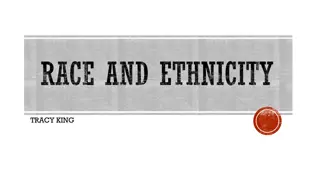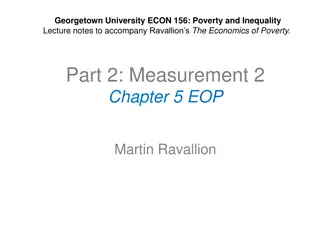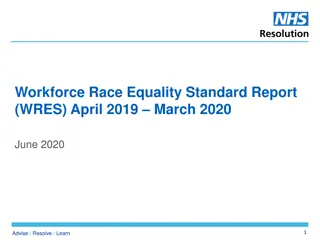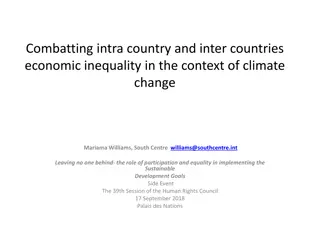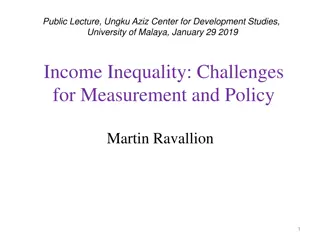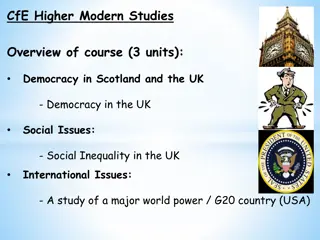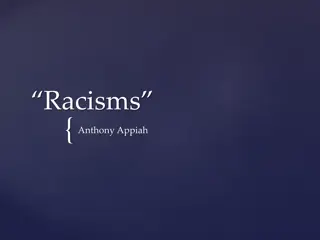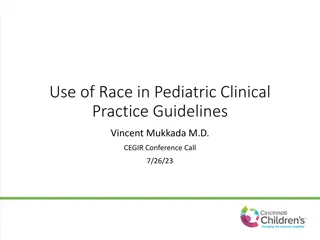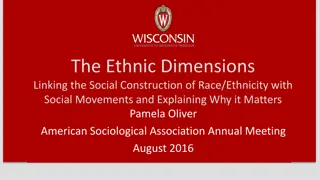Understanding Race and Inequality Through Various Perspectives
Theatre of the Oppressed by Augusto Boal explores interactive theatre as a platform to address oppressive content, while discussing the social construction of race and presenting alarming statistics on racial disparities. The concept delves into the genetics and biology of skin color, highlighting its evolutionary significance. It challenges the notion of race as a biological construct and reveals historical shifts in defining "whiteness," shedding light on the complex nature of race and identity.
Download Presentation

Please find below an Image/Link to download the presentation.
The content on the website is provided AS IS for your information and personal use only. It may not be sold, licensed, or shared on other websites without obtaining consent from the author. Download presentation by click this link. If you encounter any issues during the download, it is possible that the publisher has removed the file from their server.
E N D
Presentation Transcript
Theatre of the Oppressed (Augusto Boal) Interactive theatre with usually some oppressive content Specta-actors can intervene in the play and propose a new solution or direction by taking on a role The other actors are supposed to improvise and illustrate the difficulties with the new solution 1
Some statistics Black unemployment is twice as that of whites Schools are more segregated today than they were before the civil rights act. Schools in low income communities are underfunded and work as dropout factories Young black males are 21 times more likely to be killed by the police than their white counterparts Black incarceration rates are 5 times that of whites and in some states 10 times that of whites Median household worth White:142K, Black: 11K 3
Biology of Skin Color Europeans were black until about 8,000 years ago. Warmer climates: Melanin protects you from UV radiation disrupting processes associated with folic acid which could cause birth defects Colder climates: lack of sunlight causes vitamin D deficiency. Lighter skin color absorbs more sunlight and is good for you. Skin color does not have other biological significance 6
What is race? A social construct. Unlike skin color, there isn t a group of genes that represents race. Hypodescency counting one s race based on socially subordinate person s race (so called one drop rule ) If human history was a 200 page book, race begins in the last line of the last page The notion of white has changed over time in the US The Irish, the Italians, and the Jews, were not considered white at various points of history 7
A definition of White (1921) A White person has been held to include an Armenian born in Asiatic Turkey, a person of but one-sixteenth Indian blood, and a Syrian, but not to include Afghans, American Indians, Chinese, Filipinos, Hawaiians, Hindus, Japanese, Koreans, negroes; nor does white person include a person having one fourth of African blood, a person in whom Malay blood predominates, a person whose father was a German and whose mother was a Japanese, a person whose father was a white Canadian and whose mother was an Indian woman, or a person whose mother was a Chinese and whose father was the son of a Portuguese father and a Chinese mother. 8
Blackness was Invented in Virginia Growing tobacco was labor-intensive Native Americans were not reliable Indentured servants from home country only offered temporary solution They hit upon the idea of kidnapping Africans The language changed from free/slave to white/black Skin color became a mark of degradation and slavery that cannot be washed off 9
The origins of white supremacy Bacon s Rebellion 1676 Whites and black slaves and indentured workers deposed their governor and rebelled against their masters Eventually the rebellion was put down The white people were given new rights that blacks were denied: own property, own guns, participate in juries, in militia US constitution (1776) declared it is self- evident that all men are equal 10
Racism as an Ideological Framework Races are given characters uncivilized, violent, lazy, smart, Used to explain wars Explain discriminatory laws that subjugate people of color Explain discriminatory practices outside of the law Explain massive inequalities in privilege, power, and wealth 11
Patterns of Racism The statistical effects of racism are undeniable But the courts want to see racist intent Racism is punished when people are not clever enough to hide it We only kill black people, right? Day-in-and-day-out denial of opportunities is ignored Pathologizing black parenting practices victim blaming? 12
Affirmative action Need to take race into account when making decisions about employment, education etc. To restore a modicum of equity and fairness Undermines property interest in whiteness Michelle Alexander in The New Jim Crow Black success stories undermine Jim Crow but reinforce the system of mass incarceration Pump the few black success stories to denigrate everyone else Left: Maintains artificial scarcity and does not address fundamental inequalities. Right: Uses colorblindness to attack the marginalized 13
State of Oregon 2015 Statistics Households who own their home Black: 32.3% vs. White: 65.2% Individuals living below poverty line Black: 29.3% vs. White: 11.7% Oregon unemployment rate Black: 16% vs. White: 9% Children below poverty line Black: 33.9% vs. White:16.3% 14
Education and Criminal Justice Students who meet reading benchmark: Black: 49% vs. White: 85% Students who graduate on time Black: 57% vs. White: 71% Suspension/expulsion rates of students for blacks is 2 times that of white students. Incarceration rates for blacks is more than 6 times that of whites 15
Health Disparities in Oregon Low Birth Weight Black babies 45% more likely than white babies. Infant Mortality Black babies 33% more likely than white babies. HIV/AIDS Black people 3.8 times more likely than whites. 16



